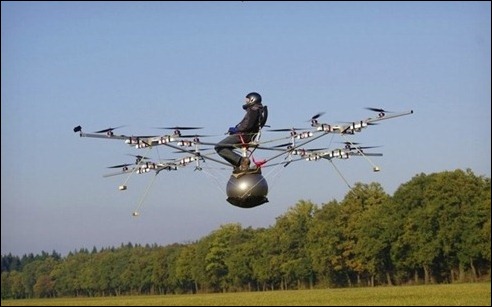The E-Volo Multicopter makes a historic flight
Posted By RichC on November 3, 2011
I’m glad there are some innovative types out there, but flying and electric sixteen propeller multicopter is not ever going to be as comforting as being in a Boeing 767 (see yesterday’s belly landing in Warsaw, Poland).
A company called E-Volo in Germany has built a spider-like multicopter that is capable of lifting a “rider”using battery powered motors. The programming of motion sensors and gyroscopes helps to property control the attitude of the aircraft and had demonstrated this on video (below) in order to makea historic flight … one for the record books I believe?
What is a multicopter?
The e-volo multicopter is an innovative, vertically starting, human carrying transportation device that is uncatagorisable to its current flight counterparts.
The e-volos sixteen propellers allow it to take off and land similar to a helicopter. Its massive plus points compared to a helicopter are the simplicity of its engineered construction without complicated mechanics and its redundant engines. Should anything go wrong, e-volo can still safely land even if up to four of its sixteen motors should fail. Flight time can last between ten to thirty minutes, depending on the payload and the capacity of the lithium batteries. With an empty weight at 80 kg (including batteries), e-volo fits into the class of ultralights.
In difference to other helicopters or multi-rotors, e-volo can use a safety parachute, as there are no propellers blocking the deployment area above.
The propellers create the full lift, and are also responsible for balancing the device on all three axes only by independent speed control of the motors. E-volo from the beginning has been designed entirely as an electrically powered device. Unlike the rotor of a helicopter, the propellers dont´t have any pitch control and therefore no wear. These factors make the multicopter mechanically simple, with close to no maintenance necessary.
The automatic attitude and directional control are taken care of by multiple separate and mutually monitoring onboard computers, controlling the engines with the precise rotation speed necessary to fly this tri-axis device. A simple joystick allows the pilot to control the aircraft via a fly-by-wire system. Whether during vertical takeoff, in flight, or landing, the pilot has to pay little attention to minimum speed, stall, gas mixture control, pitch control or one of many other things that make conventional flight as challenging as it is.
This electrically driven system is quiet, clean and economically cost efficient. A one-hour flight would cost something near to 6 Euro for electricity. In addition, the device holds few parts, which could wear out, making maintenance intervals and cost low and far between.
The control firmware can be integrated with a sophisticated integrated GPS system or obstacle detection. As such, automated flight for predetermined points on a 3D map is possible. In addition to the relieving the pilot of strenuous navigational tasks, unmanned flight would be feasible similar to other devices (drones).Possible applications
The main purpose for a single seat device would most likely be for air sports equipment and in the leisure sector. A professional application could be made in areas where helicopters are too big and expensive, for aerial photographs or field inspection of large facilities (wind turbines, pipelines), areas where its flight capabilities (vertical take off, landing, and hovering) are of crucial importance.
As a multi-seater it would also be conceivable to use for sightseeing flights, air ambulance, or air taxi.There most certainly will be entirely new use areas that no one has yet imagined.
Vision for the future
A limiting factor is still the energy capacity of modern batteries. Longer flight times are achievable, with higher energy amounts. However during flight, less is more, as you carry the extra weight, successfully voiding the capability of extra batteries.
In any case, the next few years show a significant advancement in technology applicable to life and duration capabilities of batteries. With a current flight time of on average 20 minutes, future versions promise anywhere from an hour or more. A hybrid drive, in which a conventional internal combustion engine generates the necessary electrical power, would already show an hour-long flight time.
Only then, multi-seaters with a higher payload seem better conceived for daily application. With a somewhat different approach, one could use the high cruising speeds of the e-volo multicopter to develop full-blown general aviation vehicles from a pure recreational sporting device.In some areas the multicopter may replace the average helicopter. The simple and cost efficient maintenance make it a viable counterpart to current aviational transport.

Comments